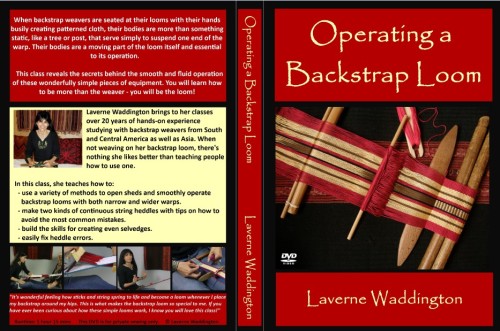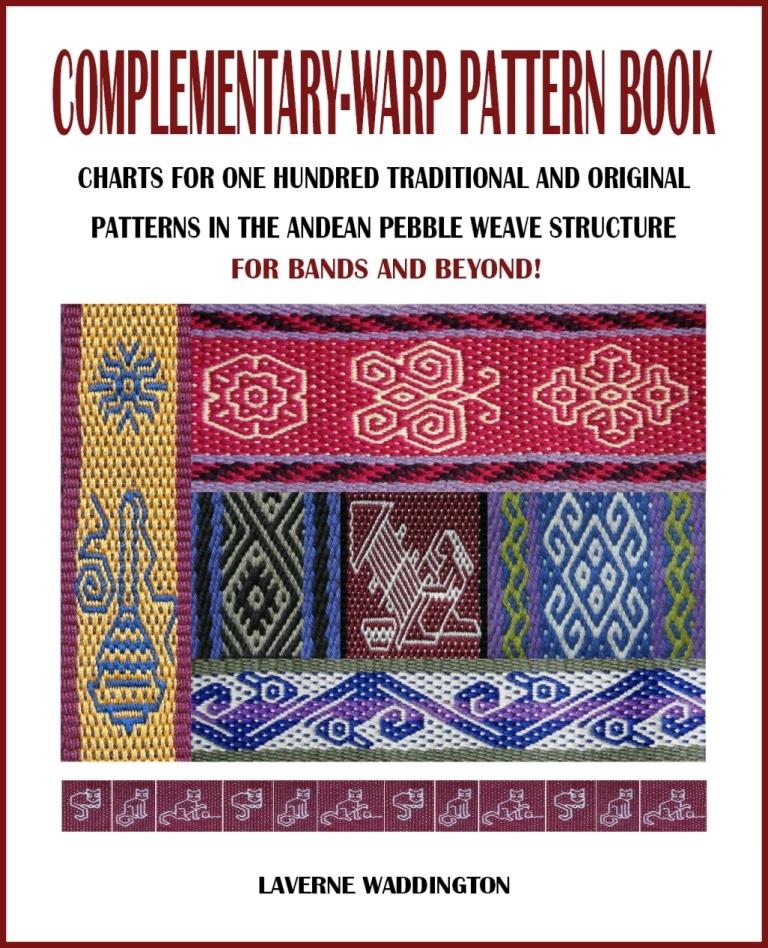My books on South American pick-up weaving techniques and patterns can be purchased at taprootvideo.com. I have written descriptions below, which include the links to the books on the Taproot Video website, to help you decide which book would be most suitable for your kind of loom, weaving style and experience level.
Foreign language editions:
Starting June 1st, 2019, my books will be available for purchase at their new home, Taproot Video. EDIT: AS FROM NOVEMBER 6, 2019, ALL ENGLISH-LANGUAGE TITLES ARE AVAILABLE AS PDFS AS WELL AS SPIRAL-BOUND PRINTED BOOKS! Here is a run-down of the growing collection:
 Andean Pebble Weave, published in 2010, is the first book in the growing collection on South American weaving techniques and patterns for weavers. It is available as a download from Taproot Video in five languages. The English-language version is also available as a spiral-bound book. It is aimed at experienced weavers. It shows how to wind the warp, create the warp- cross and prepare it for weaving leaving it up to the reader to then decide which kind of loom or what method they will use to hold the warp under tension. The two beams of the ”loom” could be as simple as the weaver’s waist and big toe!
Andean Pebble Weave, published in 2010, is the first book in the growing collection on South American weaving techniques and patterns for weavers. It is available as a download from Taproot Video in five languages. The English-language version is also available as a spiral-bound book. It is aimed at experienced weavers. It shows how to wind the warp, create the warp- cross and prepare it for weaving leaving it up to the reader to then decide which kind of loom or what method they will use to hold the warp under tension. The two beams of the ”loom” could be as simple as the weaver’s waist and big toe!
The simplest method has the weaver picking up threads to form patterns by hand. The book then goes on to show how the addition of additional sets of string heddles can make the process partly loom-controlled.
The draft and instructions are also given for four-shaft looms.
German, French, Italian and Spanish editions of this book are also available as PDFs.
(More suitable starter books for those who use inkle or other band looms are Complementary-warp Pick-up or Andean Pebble Weave on Inkle Looms. See their descriptions below).
 The follow-up book, More Adventures with Warp-faced Pick-up Patterns, was published in 2012 and takes weavers who have used the Andean Pebble Weave book further into the world of techniques used in the South American highlands and lowlands to produce intricately patterned cloth. A new structure commonly known as ”intermesh” is covered in detail.
The follow-up book, More Adventures with Warp-faced Pick-up Patterns, was published in 2012 and takes weavers who have used the Andean Pebble Weave book further into the world of techniques used in the South American highlands and lowlands to produce intricately patterned cloth. A new structure commonly known as ”intermesh” is covered in detail.
There are one hundred and fifty new Andean Pebble Weave patterns which draw on inspiration from both South American highlands and lowlands as well as adaptations to the pebble weave structure of patterns from textiles around the world. A new charting system of spots and lines is introduced with accompanying tutorials which will help weavers go beyond charted patterns to create their own designs.
 Complementary-warp Pick-up was published in 2017 and is recommended as an introduction to these techniques for weavers who can already warp and set-up their looms and confidently weave warp-faced plain-weave bands.
Complementary-warp Pick-up was published in 2017 and is recommended as an introduction to these techniques for weavers who can already warp and set-up their looms and confidently weave warp-faced plain-weave bands.
With a focus on narrow pieces and the very simplest of looms and tools, this book provides step-by-step instruction and forty-two pattern charts for band weavers to use on their inkle looms and other band looms, or with rigid heddles, or simple backstrap set-ups.
Any loom that can produce warp-faced cloth and two basic sheds can be used. The patterns are drawn on the conventional block-style chart.
A German edition of this book is also available.
 The Complementary-warp Pattern Book was published in 2018 and is a beautiful collection of one hundred patterns for those who have learned the techniques from any one of the preceding publications. Several readers of the other publications contributed their own original patterns to this collection. Those who have learned the techniques from the 2019 publication Andean Pebble Weave on Inkle Looms will also be able to enjoy this book.
The Complementary-warp Pattern Book was published in 2018 and is a beautiful collection of one hundred patterns for those who have learned the techniques from any one of the preceding publications. Several readers of the other publications contributed their own original patterns to this collection. Those who have learned the techniques from the 2019 publication Andean Pebble Weave on Inkle Looms will also be able to enjoy this book.
The patterns are charted on block-style charts. In the Appendix the patterns are also charted on the spotted charts that were introduced in the More Adventures book.
A second book of 132 patterns was published in 2019…More Andean Pebble Weave Patterns. See the description below.
 The year 2019 brought two more books to the collection. The Eye-pattern Tubular Band and Other Decorative Finishing Techniques shows how taking a piece of fabric off the loom signals the start of a whole new process in which the piece can be strengthened and decorated using tubular edgings and other woven and sewn embellishments.
The year 2019 brought two more books to the collection. The Eye-pattern Tubular Band and Other Decorative Finishing Techniques shows how taking a piece of fabric off the loom signals the start of a whole new process in which the piece can be strengthened and decorated using tubular edgings and other woven and sewn embellishments.
The tubular band with its distinctive eye pattern can also be woven independently and used in jewelry and accessories. A loom is not required. One end of the warp is attached to the weaver’s waist with the other end tied to a fixed point. Weaving the bands is not dependent on the use of heddles and all the sheds are created by hand. Detailed instructions on how to set up the warp and weave the tubular band on an inkle loom are also provided.
Two versions of the book were published. One includes the sewing techniques as well as instructions for weaving the patterned tubular band. The other only teaches the tubular band. (The shorter version is only available as a PDF).
Both include instruction via supplemental video clips as well as instructions on how to set up and weave the tubular bands on inkle looms. These books are aimed at weavers but can be used by those who don’t have any previous band-weaving experience. The PDF as well as the spiral-bound book allow access to the video clips.
 2019 also brought Andean Pebble Weave on Inkle Looms., It is aimed at weavers who like to use the standard inkle loom and who, after being able to competently weave plain-weave bands, are ready to take their first steps in one of the many possible patterning techniques.
2019 also brought Andean Pebble Weave on Inkle Looms., It is aimed at weavers who like to use the standard inkle loom and who, after being able to competently weave plain-weave bands, are ready to take their first steps in one of the many possible patterning techniques.
Two beginner methods are taught with the use of dozens of step-by-step photos, detailed text and video clips. Weavers can decide which method best suits their particular loom and weaving style. A third intermediate-level method shows an optional faster way of achieving the same results by using additional sets of heddles on the inkle loom.
Both the PDF and the spiral-bound book allow access to the video clips.
 In late 2019 I decided to re-publish all the Andean Pebble Weave patterns from the 2012 publication More Adventures with Warp-faced Pick-up Patterns. All 126 patterns plus 6 brand new ones appear in this latest publication on the more conventional block style chart. They were previously drawn using charts of spots and lines in 2012. Many weavers enjoy the spotted charts and have used them to design their very own patterns. Others, who haven’t had time to study the tutorial which explains how the spotted charts are read, have often asked me if the patterns could be re-published on the more commonly used block-style chart.
In late 2019 I decided to re-publish all the Andean Pebble Weave patterns from the 2012 publication More Adventures with Warp-faced Pick-up Patterns. All 126 patterns plus 6 brand new ones appear in this latest publication on the more conventional block style chart. They were previously drawn using charts of spots and lines in 2012. Many weavers enjoy the spotted charts and have used them to design their very own patterns. Others, who haven’t had time to study the tutorial which explains how the spotted charts are read, have often asked me if the patterns could be re-published on the more commonly used block-style chart.
More Andean Pebble Weave Patterns is for them but it will also be welcomed by those who don’t own the 2012 book and who have learned the techniques from my more recent publications Complementary-warp Pick-up and Andean Pebble Weave on Inkle Looms. This pattern book provides 132 charts with patterns that have been adapted from textiles produced in various regions around the world….Kuba cloth of Central Africa, Komi knitwear, belts with patterns of Russian origin, yurt bands and satchels from Central Asia, historic and contemporary tablet-woven motifs, as well as patterns from textiles woven in the highlands and lowlands of Peru and Bolivia.
 Published in April 2020…Warp-faced Double Weave on Inkle Looms
Published in April 2020…Warp-faced Double Weave on Inkle Looms
This is an advanced-level technique aimed at weavers who use a standard inkle loom. By that, I mean the kind of inkle loom that uses individual string heddles and which requires the weaver to lift and lower one layer of threads with the hands to create the two basic sheds. I use an Ashford Inklette in this book to teach and demonstrate the technique using its two basic sheds. There is a bit more work involved in setting up the loom and weaving requires extra care and attention (hence the advanced-level rating). It is also one of the slower techniques that I have learned in South America. However, it is one of the easiest structures for designing and I liken it to doodling on plain weave.
The structure does not use warp-floats and so the surface of the band is perfectly smooth. The motifs are identical on the two faces with colors reversed. Angular, curve-like, solid and delicately outlined figures can be produced. The book has 45 pattern charts. Chapters on designing take you through the steps for sketching, charting and planning the layout of patterns. You are also shown how easy it is to chart a motif from an image of a woven textile.
Video clips supplement the instructions and accompany both the PDF and book editions.
A section is dedicated to Finishing and includes tutorials on a braid and weft twining.
My DVD on Operating a Backstrap Loom available for streaming or as a dvd from Taproot Video.
I made this video to answer the questions that I am most frequently asked when weavers are setting up and using a backstrap loom…how to make string heddles and how to make them even! What to do when you find a mistake in your heddles, how to open sheds cleanly and smoothly without over-working the heddles and shredding the warp threads or building up fluff and pills on the heddles, how to change the set-up to suit wider warps, how to handle the weft to create neat and even edges. It shows you how to use your body as a moving part of the loom itself.
It is not a start-from-scratch guide. My article Backstrap Basics gives you a lot of start-from-scratch information about what pieces you need to make your loom and backstrap and how to install simple heddles. My free video Basic Warping for Backstrap Looms gives you tips on how to create simple stakes around which to wind warps as well as the methods for creating warps for both plain and pick-up bands. The Operating a Backstrap Loom video takes you beyond all that.
############################################
ARTICLES

BACKSTRAP WEAVING IN LATIN AMERICA – An article in Shuttle Spindle and Dyepot summer 2010
#################################################
 The Handwoven team wrote a Spotlight article about my weaving in the November/December 2010 issue.
The Handwoven team wrote a Spotlight article about my weaving in the November/December 2010 issue.
###########################################

An excerpt from an article I wrote on Meaning in Cloth in Bolivia appears in the Jan/Feb 2011 issue of Handwoven.
########################################

An article in the Spring 2015 issue of Handwoven in which I describe the connections I have made in the world of backstrap weaving and their influences on my work.
I contributed articles to the published proceedings of the international conferences of the Braids Society held in Manchester, England in 2012 and Tacoma, WA, USA in 2016.
 I was asked by Devin Helmen to contribute to his article ”Honest Cloth” in the summer 2019 issue of Spin Off.
I was asked by Devin Helmen to contribute to his article ”Honest Cloth” in the summer 2019 issue of Spin Off.

An article on my experiences learning to weave in South America in Issue 9 (November 2020) of Tiny Studio Creative Life magazine.

























Thanks for the help Laverne, your so quick! ;O)
I found that once the ebook was in my shopping cart I needed to choose the ‘Checkout’ button instead of the ‘Checkout with PayPal’ button. I could then enter all my details and choose payment by card or PayPal.
I’m delighted with the PDF and plan to read and absorb it all weekend.
Thanks again!
Z
By: Zaferina on August 12, 2010
at 10:01 pm
regards from guatemala !!
By: lucia on August 7, 2011
at 12:10 am
Hello there in Guatemala!
By: lavernewaddington on August 7, 2011
at 12:55 am
Not sure where I should ask this BUT…..
I bought your ebook Andean P W and just love it. I’ve been making single bands and practicing. Tonight I decided to warp a wider piece using plain black borders and a couple of 4 revolution patterns with a ten rev pattern in the centre separated by 6 black plain weave. I can make the pebble sheds, but not sure what to do in the plain sheds. I made string heddles for the pebble 1 shed and when I got to the plain shed I included all the warps on the bottom cross (D shed in your book). Then in the pebble two shed i put warp from the top cross stick in the heddles for the plain weave part This doesn’t seem to be working. Any help would be greatly appreciated.
Sincerely
Lynda
By: Lynda Sully on February 12, 2012
at 1:01 am
Hi Lynda,
It’s nice to see that you are trying out wider pieces. Any plain weave sections in the warp will be set up in exactly the same way that you set up the borders. So, both pebble sheds will hold the same warps for border and all other plain weave areas. All the plain weave warps on stick C (the back stick) will go into the heddles with pebble sheds 1 and 2. Both pebble heddles will have the same plain weave warps. So, each time you use pebble heddle you raise the plain weave warps on stick C and then you alternate that with your pattern sheds which include the plain weave warps on stick D.I hope this helps. Just think of the plain weave parts as wide borders!
By: lavernewaddington on February 12, 2012
at 1:48 am
Thank you so much….you’re awesome! Ill be trying that first thing in the morning. Just love using your book….it has such clearly worded instructions. I’ll keep at it until I get good enough to actually make something! Thanks again!
By: Lynda Sully on February 12, 2012
at 3:58 am
Hello Laverne,
Great tutorial on supplementary weft, you made it very clear. I have just come back from Burma where they have backstrap weaving in Shan State – a woman was using part of a plastic seed sack as a backstrap, another had the backstrap made from the hide of a barking deer. They do supplementary weft weaving in Chin State but I didn’t get there. Best wishes, , Robin
By: robin lambert on July 11, 2014
at 12:17 pm
Hi Robin.Lucky you to have had a chance to travel through Burma. I heard much about it from my student, Emerald. I hope you will try the supplementary weft technique.
By: lavernewaddington on July 16, 2014
at 8:46 pm
I’m looking for a wave type pattern….to Be used in book marks for an organization called living waters….do any of these books gave such a pattern and if so, could I see a picture? Your books are definitely on my wish list!
By: Beth on December 18, 2018
at 7:56 pm
I have emailed you a reply and an example.
By: lavernewaddington on December 20, 2018
at 7:27 pm
Hello Laverne,
I’ve bought your “Operating a backstrap loom” video and the “complementary warp pick up” Pdf.
I’m more than happy with the results and nice patterns I’m now able to weave.
I’m looking now for more patterns to weave more bracelets, small bags and largest pieces.
which of your book would be the most appropriate for me ?
Many thanks for your work, for your books and videos that are very well explained
(I’m french, your way of teaching is clear and easy to understand).
Thanks again !!
Magali.
By: Magali Donadio on March 6, 2019
at 8:26 pm
Hi Magali. Thank you for this lovely comment. I am pleased to hear that you are enjoying the techniques. I have a book of 100 patterns that is a nice follow-up to the Complementary-warp Pick-up book that you have.It is called Complementary-warp Pattern Book. Here is the link.
By: lavernewaddington on March 6, 2019
at 10:17 pm
I’m having trouble with long floats in Complementary Warp Pickup–for example, with 6 thread pattern, ? With dark thread in position 6 (on left) on three successive picks–does that act as a float?
If position 6 (left-most) dark thread is preceded by light thread–how do you follow rule to “skip next dark thread”?
What don’t I understand?
By: Michelle Simon on August 28, 2021
at 10:00 pm
Hi Michelle. The threads in the patterns that you are creating on those 6-thread warps do form floats. If the dark thread in position 6 is picked in three successive sheds, it will form a 3-span float, that is, 3 shots of weft pass under that dark thread. This is the longest float that is created in those patterns. You are supposed to be forming floats.
As for the second part of your question, if the chart tells you to pick the dark thread in position 6 after having picked a light thread, the light thread that you should have picked is the one in position 5. So, you pick the light thread #5, skip dark thread #5 that immediately follows it, and then pick dark thread #6 (ignoring light thread #6 on the way).
I hope this helps. Don’t hesitate to ask if you have other doubts or questions.
By: lavernewaddington on August 28, 2021
at 10:17 pm
Many thanks! I was actually doing it correctly….just didn’t believe it…..Stay safe–we’d love to see you in Santa Cruz, CA, in the future! (I would love to take a class in person in backstrap weaving–have two warped looms–from Guatamala….but haven’t gotten around to trying to follow the video yet.)
By: Michelle Simon on August 28, 2021
at 10:20 pm
Oh good. Yes, sometimes you just need confirmation. Are you in the guild there in Santa Cruz? I love that place and have woven with a group there on many occasions.
By: lavernewaddington on August 28, 2021
at 10:32 pm
Yes! Now called “Santa Cruz Textile Arts Guild”–just switched from scheduled “in person” meeting to another Zoom meeting because of the resurgence of CoVid variant delta locally….(I’m currently immune suppressed so am staying home weaving…..)
Travelled to Guatemala with family (when they lived in NIcaragua) several years ago and took grand daughter to village to ‘learn”/see backstrap weaving up close! I have almost all your books, too….
By: Michelle Simon on August 28, 2021
at 10:36 pm
Yonat, Barbara and Peggy are my backstrap weaving friends there. I hope you have a chance to get together with them some time soon. In the meantime, yes, do stay home and stay safe. Guatemala is amazing. That was a nice opportunity for you and your granddaughter and how nice that you have those two looms. Take care and happy weaving.
By: lavernewaddington on August 28, 2021
at 11:43 pm
Dearest Laverne in the last image above (the article of Tiny Studio Creative Life Magazine) there is a fabric background with leaves. Where can I please find your explanation for this type of weaving? is it perhaps the intra-mesh technique? Thanks so much
By: Isabella Rapex on January 22, 2023
at 9:20 am
Hi Isabella. That piece with the leaves is warp-faced double weave. I have written a book about the technique which includes a chart of the leaf. Here’s the link to the Taproot Video site where you can purchase the book. https://www.taprootvideo.com/preview_class.jsf?iid=3&cid=15
By: lavernewaddington on January 22, 2023
at 1:40 pm